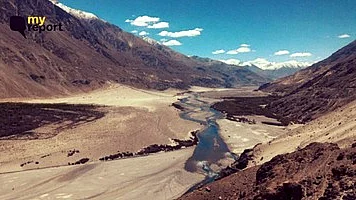“We would either burn it or throw it in the Indus River,” said a bright-smiled Tashi Namgyal, a local of Choglamsar town. I was asking him about solid waste disposal before December 2017.
Choglamsar is the most populous town in Leh District after Leh City. The town is nestled along the Indus, dotted with majestic poplar trees and sprinkled with commercial shops and restaurants. Similar to all touristy places, Choglamsar has responded to increasing tourism with an enthusiastic increase in shops, restaurants and guesthouses. And consequently, an increase in garbage.
Ladakh witnessed a surge in tourism in 2010. Some credit this to the hit Bollywood movie 3 Idiots. The remnants from the movie – a yellow scooter for which tourists can pay Rs 50 and get photos clicked, and Phunsok Wangadu Cafés – can still be seen at the Pangong Lake. While the boom in tourism has given a kick to local incomes, it has brought with it thes daunting issue of waste management.
To illustrate, in the tourist season (May-Aug), Leh City collects about 16-18 tonnes of waste, while in lean season (Nov-Feb), the city collects about 3-4 tonnes, about 4 times less!
The Leh Administration is conscious of this issue. In December 2017, the Rural Development Department (RDD), Leh with support from the District Administration and Ladakh Autonomous Hill Development Council (LAHDC), launched its pilot solid waste management project in Choglamsar. The idea was to conduct a pilot and then refine and replicate it across the district.
Under the project, multiple training workshops were provided to the community on segregation of organic and inorganic waste. Thereafter, two separate bins (green for organic waste and blue for inorganic waste) were provided to all households and commercial shops/restaurants. Segregated waste was then collected and brought to a waste collection centre managed by RDD.
At the centre, organic waste was put for composting while inorganic waste was systematically divided into 17 categories (plastic, cardboard, cloth, etc). These 17 categories of waste were then resold/reused/disposed in a careful environment friendly manner.
How this categorised waste was resold/reused/disposed is interesting. It is important to keep in mind, Leh is situated in the north east corner of Jammu & Kashmir, 417 kms from Srinagar and remains cut off all winters (for the snow blocked roads). Given the inaccessibility and high cost of transportation, RDD had to find ways to locally dispose the waste, and following is the beauty that unravelled.
Some amount of cloth and paper waste was sent to PAGIR, an organisation run by physically disabled persons who ‘turn waste to wealth’. The organisation makes beautiful key rings, pen holders, card holders, etc which are linked to the market. A paper pulping machine was provided to the organisation by the District Administration to ease their work. Some paper waste was also used to make paper bricks. These bricks can be used for insulation in winters or as fuel for household chimneys.
A truck of plastic waste was sent to ACC Cement plant in Himachal, where they used the same as fuel under controlled conditions in an environment friendly manner. Another truck was sent to a local vendor in Srinagar. RDD is currently in talks with HIMANK, to reuse plastic in black topping of roads.
Glass has been used in construction of local houses.
The Choglamsar model has proved to be successful and creative.
As of June 2018, the Centre collected about 19,227 kgs of solid waste and earned of about Rs 26,204 by resale (since Dec 2017).
The amount earned is an incentive as it is deployed back in the centre. Given the success of the pilot, RDD is now replicating the model in other touristy spots like Nimoo, Diskit and Pangong. It is also augmenting the infrastructure at Choglamsar to make it a nodal point for final collection of wastes from all other centres.
The factor buoying success of the model is quite evident – the will of the RDD and support of the District Administration and LAHDC. Unlike other areas of our country, Leh sets a high standard for coordination and cooperation among departments. When the project was rolled, RDD already had all the help and guidance needed from the municipality. Also, they are open to suggestions, feedbacks and reviews. I recall when I tried to have a conversation with the Principle Secretary, Agriculture, Rajasthan, some years ago after a thorough ground research, he cut me short with – “We already know everything”. That’s not the case in Leh. The Assistant Commissioner for Development (in charge of the project) gracefully provides interviews and carefully listens to suggestions.
Another very important factor, which we in the ‘policy and change’ circle tend to negate or undermine, is – the will of the local community. The locals were punctual and participative in the training workshops. They wanted to know where their waste was going. They were conscious of the increasing waste. They wanted to do something about it. Each household pays Rs100 per month towards the segregation centre, while commercial areas pay Rs 200 per month. They set an example to be part of the solution rather than expecting solved and perfect results.
(Neha Tomar is an avid reader and travel enthusiast. With experience in policy and development, she is currently working as an independent CSR Consultant.)
(At The Quint, we question everything. Play an active role in shaping our journalism by becoming a member today.)
